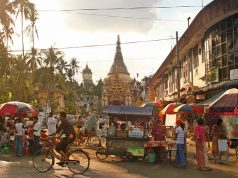As the aircraft begins its descent to- wards the Mingladon airport, the view from the window is of numer- ous water bodies, the Yangon River, sever- al lakes, besides small ponds and streams. Myanmar has a 1930 km coastline as it bor- ders the Bay of Bengal and the Andaman Sea. Further inland, there are large rivers like Ayeyarwady, Sittuang, Chidwin, Thal- win and a part of the Mekong river basin that stretch across 2000 km besides another 2600 km of their tributaries and smaller riv- ers. It is only natural then, to find an amaz- ing variety of fish and seafood in Myanmar. Fish, along with rice is principal staple fare for the people of Myanmar, who love small fresh fish with their meals, besides using dried fish and fermented fish paste in plen- ty for numerous exotic preparations. A dis- tinct fish aroma permeates the air especially around eating places, which one gets accus- tomed to, gradually.
For someone who has grown up in a land- locked place, fish is an acquired taste, en- joyed, but even after decades of eating it, reservations persist about quality, odor, and freshness, and many a time I can’t help wrinkling my nose. Bones of the smaller fish scare me still, and I have never quite under- stood how native fish eaters are able to col- lect the bones and discreetly remove them to their plate.
In the last three decades, I have lived in places like Kolkata, Singapore and Bangkok, all of which are famous for fish and seafood, and widely perceived to have some of the world’s freshest fish varieties. But it is here, in Yangon, that I have found the fish to be the freshest, and hence completely odorless. The fish available in the market passes the freshness test I learnt-the meat is pink and moist, the scales are intact, the color is not dull and the gills still look pinkish red and not brown. Not knowing the language, the easiest was to buy fish initially from Citymart that carries the English names of the local fish varieties on sale. However, in a matter of days I found the Inya Road market, one of the many wet markets around town, and the fish on sale there, seemed even fresher. I somehow found it close enough, convenient, clean and cheap, and it has been my fish source for nearly two years now. It was here that I discovered the following:
Rohu- NgaMyit Chin – I was thrilled to find this freshwater brackish fish on my first trip to the market. Easy to identi- fy, this is one of the most popular fish varieties cooked all over Asia. Though bony, it belongs to the carp family, grows up to 200 cm in length and can weigh up to 45 kilograms. And the big- ger the fish, the tastier it is. Rohu has a smaller head and silver scales that darken with a tinge of red closer to the tail, and is generally big in size. Not too fond of smaller, finer bones for fear of choking, I prefer to buy the middle sec- tion of a big fish and prepare it like an Indian curry, to be eaten with rice. At Inya market, the fish vendors cut the fish into perfect pieces for curries and frying, and even remove the skin and scales completely, if preferred. Once cut, the meat is pink. It cannot be made into boneless fillets though. A dash of mustard, a mild flavor of garlic, Rohu makes for the most sumptuous after- noon meal.
Katla- NgaThaingGuangBua- Katla is another carp variety, a scaly freshwater fish that has a marked resemblance to Rohu, in size and appearance, except that it has a much bigger head and an upturned mouth. It is thicker around the middle and its deep body helps in differentiating it from other fish. Again, it is bony but with lighter pink meat when cut. Here too the midsection is the best cut. Native fish eaters love to prepare fish-head curry, while I am happy preparing a coconut milk based curry out of small less bony pieces, hap- pily leaving the skin, scales, head and tail for the fish vendor!
Mrigal- NgaGyin- It took me a long time to find the English name for Nga Gyin, that everyone spoke about. It is actu- ally ray-finned white carp. It is one of the most popular widely cultured fresh water fish varieties with fine white meat inside its silver, scaly exterior. Again a freshwater fish, it survives in fast flow- ing streams and grows extremely fast and up to a maximum length of one me- ter. The first time I bought Nga Gyin, I found it to have a very fine taste, and have since, used it for frying and mild gravies.
Hilsa- Nga Tha Lauk- The hilsa is a fish of the herring family, extremely flavor- ful and delicious. It is a silver colored tropical fish with a purple overtone and easily identifiable amongst the other varieties. For the people of Bengal and Bangladesh, it is the ultimate delicacy with its soft, smooth and creamy taste. The hilsa has an interesting life pat- tern since it spends its life in the sea and then migrates for spawning up to 1200 km inland through rivers. This migration typically takes place during the monsoons. The fish breed in fresh- waters and then move to the sea as the young ones grow. I had been hearing of hilsa for years in Kolkata, but could never attempt eating it due to its hun- dreds of fine bones. I was pleasantly surprised to try Hilsa prepared Myan- mar style at a friend’s place, where it had been soaked overnight in vinegar, which melted its bones completely and I was able to savor every bit of it!
- Butterfish- Nga Dang and Nga Myin – I loved this fish the first time I ate it, pri- marily because it was boneless. With a big center bone that is easy to remove it can be cut perfectly into fillets and cubes. I am told that there are two va- 7. rieties of butter fish, the lean nga myin that is the dearer, finer butter fish, and one that is true to its name, and loaded with butter-the layers of fat are visible and just have to be discarded-this is nga dang, the cheaper variety, delicious but probably too fatty, unless stripped clean of all the surrounding fat. This fish is ideal for frying, grilling and bar- becuing, and seemed to lose its softness when I once to prepare it as a curry. Butter fish stands out as a fresh water fish, with its smooth silvery skin, dark- er on top and nearly white below, and a flat body that is extremely broad in the middle.
- Seabass-Nga Ka Kadit- Seabass is an old favorite available in other countries, and always a safe bet, having neither a strong odor nor too bony, and its fillets are the easiest to cook. It took me a while to find out its local name, where after it was easy to buy. I learnt that there is extensive pond culture of sea- bass, which besides the local market is exported to Australia, and its culture is being encouraged since it is a spe- cies easy to produce, and highly lucra- tive. Seabass catch comes from shrimp ponds as well. It was interesting to find out that a new variety of seabass is cul- tured in easntern Myanmar and has been named ‘lates uwisara’, as a tribute to the famed Myanmar monk U Wisara who died while on hunger strike to re- volt against British rule. Seabass is uni- versally liked and adapts to all styles of cooking, retaining its taste, texture and moisture, as it melts in the mouth.
- Grouper- Nga Tauk Tu/Nga Kya Uk- The day I find a Red Grouper in the market becomes a feast day, since I love to steam it whole, with fresh herbs and spices, and serve with the flavorful Myanmar Basmati rice. There is a vast market for Grouper and it is also ex- ported live, mainly to Hong Kong. I did not know that twenty varieties of Grou- per can be found in Myanmar waters, and are now cultured in ponds and net cages. However, it is not one those fish varieties that are seen every day in the market, and never in plenty. For me, red Grouper stands out with its orange red colored scaled body and more of- ten than not, one finds small sized fish weighing up to 2 kilograms.
- Tilapia- Nga Yan- I believe the local people call it tilapia also. Tilapia is an easily available fresh water fish, and now being cultured extensively to feed export markets including the vast US market since the import ban was lifted, where it is the fourth most popular plat- ed fish. Its high protein content and fast growth makes it easy to farm besides being highly lucrative. Tilapia tastes best when grilled, but it is not one of the fish varieties I buy often. It is supposed to be rich in Omega-3 and Omega-6 fat- ty acids, but then that’s true for other varieties as well.
The list can go on, but I probably will not even be able to find local names for the numerous varieties available and enjoyed by the locals. There is plenty of fresh and dried fish available in the markets, but I un- derstand that though fish exports must be permitted after local consumption has been provided for, this is not generally the case. Lack of sufficient data prevents an accurate calculation of the gap between demand and supply of fish for local markets. As of now, only a handful of the 450,000 fish and
shrimp farms are able to produce fish that matches international standards, and this has led to a decline in export earnings by the fishery sector by over $116 million over last year. This is disappointing since fisheries stand third in earning foreign exchange for the country.
There is obviously a tremendous opportuni- ty waiting to be tapped to its fullest potential with Myanmar’s abundant freshwater and brackish water fisheries. The vast river sys- tems run from north to south in the country and offer promise of tens of thousands of tons of marine products and seafood. It is only a matter of time before foreign invest- ment and participation in introducing the latest fish culture and farming techniques yield seafood that is comparable to the best in the world.










